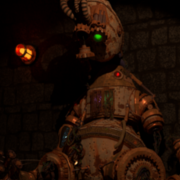Thanks for the quick reply. And no worries about a vague answer, especially since I didn't post any details, that's mostly what I was looking for anyhow (and you're still rather specific  ).
).
And, I should have been clearer with my comment "The object is there, it just is rendered invisible/transparent". Also, now when looking into this, I'm a little more confused. To explain, where the object ought to be rendered, there's a transparent hole in the game world in the shape of the object (you can see through the ground, characters, etc). However, it occurs to me now, the odd thing is that you see all the way to the skybox,..which confuses me as there is no difference I can see between the skybox and the ground, rendering-wise, so I'm not sure why that still shows behind, and not just the glClear color . The order of rendering the objects doesn't affect this.
It's probably important to note here, that I'm only outputting a vec3 for color in the normal-mapped object's shader, and not tinkering with the alpha. Whereas the other object's shader I do output a vec4 with the alpha value.
And, upon a little further investigation, the difference with the skybox and the skybox's shader, is that, unlike the other objects, I'm not using a texture array for it.
It's rather late for me, but I'll try to pin things down more accurately tomorrow by using your suggestions with the shader's normal values. I have a few more ideas now, I'll test out to try to pin this down a little closer.
Thanks for the help Haegarr. If I still can't sort things out, I'll go ahead and post the whole shebang here (in a simplified form, of course). I realize it can be frustrating for anyone to help without seeing the code.
**Edit**
Alright, I toyed with things a little this morning, and it looks like it's probably a trivial error somewhere. In my simple program, I'm easily able to render an object with a normal map alongside an object without and they both display fine. My method is the exact same as my larger project, as far as I can tell, but obviously I'm making a small mistake somewhere. But, it shouldn't be in the way that I'm doing things. So, somewhere in my larger program I'm doing something that is resulting in the transparent object.
I'm kind of back to where I started, but at least I've ruled out that it's something to do with my method of rendering things. I'm still totally open to ideas though, as I would like to integrate normal mapping into my larger project, and I'm still at a bit of a loss where to look for the mistake (it's rather a large project, for me at least). I'll likely just start going through things with a fine toothed comb. But, first some food and family. Happy Thanksgiving all!





